By Eric Francis Coppolino | Link to original
Dear Friend and Reader:
Tuesday, the Roe v. Wade decision of the U.S. Supreme Court has its 40th anniversary. As I imagine most people know, this was the court’s 1973 landmark ruling that defines a woman’s right to terminate an early-term pregnancy, in consultation with her doctor.

Less often discussed is the extent to which the the right of a woman to choose her reproductive destiny influences every other aspect of her life.
Borrowing some logic from The Second Sex by Simone de Beauvoir, the female body is the reproductive pod, with its own set of biological instructions; the one who inhabits the body gains the distinction of person through her ability to determine the course of her own life. And for a woman, that includes deciding whether, and when, to have children.
We don’t have an Equal Rights Amendment in the United States. The ERA, had it passed, would have said (it’s very short), “Equality of rights under the law shall not be denied or abridged by the United States or by any state on account of sex.” Too bad that one didn’t go through. I believe that Roe v. Wade is the closest thing we have to it, particularly if you think that on the physical plane, biology influences destiny.
Few decisions in Supreme Court history have stirred up more controversy than Roe. Yet if you read it, the decision itself is not especially controversial, except of course for its logical result. It analyzes the issues thoughtfully and weighs the interests of the parties involved: the pregnant woman, the fetus and the responsibility of the state to regulate a medical procedure in order to protect the safety of the patient.
This is prudent given that in the 20th century, as many as one in six women who had an abortion died as a result of the procedure. The decision also protects the rights of the fetus upon reaching viability, including with life support, now held by the court to begin anywhere from 24 to 28 weeks into the pregnancy. The decision also attempts to clarify the legal issue of what a “person” is, since it’s not defined in the Constitution, and decides that it does not include the unborn.
Background and the 44-Second Time Difference
Before we get into the truly fascinating astrology of the decision — my purpose for writing today — I think it’s a good idea to have some background on the decision itself, you know, a little actual information about what was at stake. Just as a preview I will say that the chart for the decision is timed such that 44 seconds changes the rising sign. This, in turn, changes key rulerships in the chart, in a rare case of a chart changing entirely with less than one minute’s difference in the time.
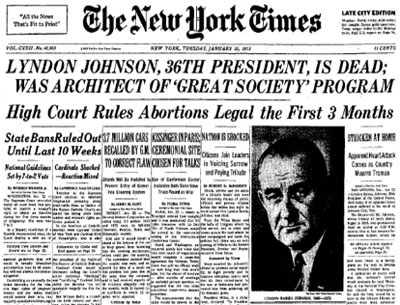
In Roe v. Wade, the court was reviewing the legality of an old Texas statute that made it illegal to “procure an abortion,” except with respect to “an abortion procured or attempted by medical advice for the purpose of saving the life of the mother.” Texas also allowed abortion in cases of rape and incest.
The case challenging this law was brought by Norma L. McCorvey, whose name was changed in court documents to Jane Roe. Pregnant with her third child in a state where most abortion was illegal, her friends suggested she claim to have been raped, so she could get a legal one. But she had no police report demonstrating that claim, so she then attempted to obtain an illegal abortion but found that the site had been shut down by police. She was out of options. By the time her case was litigated, she gave birth to the child and gave it up for adoption.
With the help of a legal team that was looking for a plaintiff to challenge the Texas law, McCorvey sued Texas (personified by Henry Wade, the Dallas County district attorney who also happened to be presiding at the time of the Kennedy assassination a decade earlier). She lost her case and her initial appeals, and then appealed to the U.S. Supreme Court.
The court, in a 7 to 2 decision, determined that the Texas law was vague and unconstitutional, and infringed upon McCorvey’s right to procure a safe abortion, including violating her liberty, her right to privacy and her right to due process. “Due process” means that in theory, when the state takes away someone’s freedom, they do so in a judicially sound way.
In a concurring opinion affirming the majority ruling, Justice Potter Stewart wrote, “Clearly, therefore, the Court today is correct in holding that the right asserted by Jane Roe is embraced within the personal liberty protected by the Due Process Clause of the Fourteenth Amendment. It is evident that the Texas abortion statute infringes that right directly.”
And he added, “Indeed, it is difficult to imagine a more complete abridgment of a constitutional freedom than that worked by the inflexible criminal statute now in force in Texas.”
The court also held that the longer a pregnancy lasted, the more the state’s interest in regulating that pregnancy increased. In the first 12 weeks of the pregnancy, the decision was up to the pregnant woman and her doctor. In the second 12 weeks of pregnancy, the health of the pregnant woman becomes the focus, and in the last 12 weeks (when the fetus becomes viable), the state has the most rights and may even ban abortion.
A History of Controversy
On and off throughout history, abortion has been a source of controversy, in part because abortions were so dangerous for so long, far more dangerous than childbirth until the 1930s. Other sources of controversy seem to involve the fact that in marriage, a woman can be considered chattel property, and that historically, men have a claim to the heirs to whom women give birth.
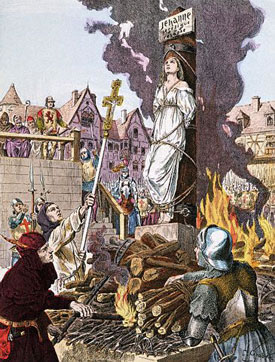
The court was aware of the territory it was stepping into. Harry Blackmun, the author of the court’s majority opinion, framed the controversy in almost poetic terms:
“We forthwith acknowledge our awareness of the sensitive and emotional nature of the abortion controversy, of the vigorous opposing views, even among physicians, and of the deep and seemingly absolute convictions that the subject inspires. One’s philosophy, one’s experiences, one’s exposure to the raw edges of human existence, one’s religious training, one’s attitudes toward life and family and their values, and the moral standards one establishes and seeks to observe, are all likely to influence and to color one’s thinking and conclusions about abortion.”
And he adds, in a true statement of the times: “In addition, population growth, pollution, poverty, and racial overtones tend to complicate and not to simplify the problem.”
However, the zealous intensity around the issue we are used to is a relatively new thing. In its decision, the court includes a summary of the history of abortion, acknowledging, “It perhaps is not generally appreciated that the restrictive criminal abortion laws in effect in a majority of States today are of relatively recent vintage. Those laws, generally proscribing abortion or its attempt at any time during pregnancy except when necessary to preserve the pregnant woman’s life, are not of ancient or even of common-law origin. Instead, they derive from statutory changes effected, for the most part, in the latter half of the 19th century.” Note, this is among a lot of things that we take for granted as having existed forever; the 19th century was a festering pond for very bad ideas written in very good English.
It is worth noting that abortions were an issue in what are called the burning times — the murder of alleged witches in Europe that lasted for centuries, as part of the Inquisition — because often the term “witch” really meant wise woman, midwife and herbalist who knew how to prevent conception and terminate a pregnancy.
Skipping ahead a bit, among the most vocal opponents of abortion in the 19th and into the 20th centuries was the American Medical Association (AMA), which has done more than its share of witch hunting over the years. Even as late as 1967, the AMA took a stand objecting to abortion except when the pregnancy threatened the mental or physical health of the mother or the life of the mother; cases of rape or incest; and situations where the child was expected to have a birth defect.
By 1970, the AMA was starting to change its tune. According to the text of Roe v. Wade: “[The AMA] emphasized ‘the best interests of the patient’, ‘sound clinical judgment’, and ‘informed patient consent’ in contrast to ‘mere acquiescence to the patient’s demand’. The resolutions asserted that abortion is a medical procedure that should be performed by a licensed physician in an accredited hospital only after consultation with two other physicians and in conformity with state law, and that no party to the procedure should be required to violate personally held moral principles.”

The ruling makes the issue clear: “The prevalence of high mortality rates at illegal ‘abortion mills’ strengthens, rather than weakens, the State’s interest in regulating the conditions under which abortions are performed. Moreover, the risk to the woman increases as her pregnancy continues. Thus, the State retains a definite interest in protecting the woman’s own health and safety when an abortion is proposed at a late stage of pregnancy.”
The court also admitted that the state has some interest in protecting prenatal life, ruling that:
Some of the argument for this justification rests on the theory that a new human life is present from the moment of conception. The State’s interest and general obligation to protect life then extends, it is argued, to prenatal life. Only when the life of the pregnant mother herself is at stake, balanced against the life she carries within her, should the interest of the embryo or fetus not prevail.
Logically, of course, a legitimate state interest in this area need not stand or fall on acceptance of the belief that life begins at conception or at some other point prior to live birth. In assessing the State’s interest, recognition may be given to the less rigid claim that as long as at least potential life is involved, the State may assert interests beyond the protection of the pregnant woman alone.
In the end, the court held that women have the right to make their own decisions about pregnancy, in consultation with their medical doctor, up to the point where the life of the fetus is considered viable — for three months in all cases, and then potentially for an additional three months into the pregnancy where her health is an issue.
The court described a right to privacy stemming from an earlier decision about birth control, Griswold v. Connecticut, holding: “This right of privacy… is broad enough to encompass a woman’s decision whether or not to terminate her pregnancy. The detriment that the State would impose upon the pregnant woman by denying this choice altogether is apparent.”
And Now for the Chart — or Charts
Looking at the astrology, we can get some insight into the nature of the controversy. There is actually a chart for this ruling. Data collector Lois Rodden (1928-2003), founder of Astrodatabank, states 10 am as the time, based on when the court goes into session. Rulings are then read and the text is made public. [To see the chart I’ve been working with, visit this page.]
This is one of those rare charts where 44 seconds makes all the difference in the world. If you cast the chart for 10 am, using the exact location of the Supreme Court building, you get very late Pisces rising — that is, the last quarter-degree of the zodiac is on the horizon. If you cast the chart for 10:00:44 am, you get a chart with the first degree of Aries rising — the Aries Point.
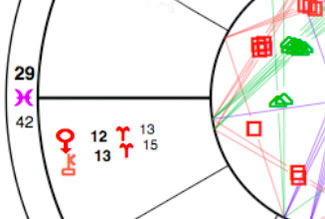
This is an edgy chart, on the edge. The last degree of Pisces rising describes the transitional nature of the issue. When a mutable sign is rising, there’s sometimes not a strong hold on physical reality. However, I attribute some special properties to the last degree of Pisces, as it’s the end of the entire astrological wheel. In my experience, it’s a degree where you look for ways that the situation is the exception to a rule.
When you advance the time by less than a minute, that puts the first degree of Aries rising; the Aries Point is exactly on the ascendant. As I have written many times, the Aries Point is about the intersection of private and public life; the place where the personal is political. Indeed, this particular case is as personal as the political gets.
The stated time of the court going into session is 10:00 am (late Pisces rising). But obviously, it took the justices longer than that to settle in, the chief banged the gavel, and it took a moment for the audience to hush up; there was obviously a crowd in the courtroom that day. Then the decision was announced and distributed; this was probably later in the hour.
However, by 10 am the decision was finalized and printed and for all practical purposes, already in effect. So the main chart becomes the stated time chart. This is a documented phenomenon in astrology.
This changes more than the rising sign, though that in itself is significant. In mundane astrology — that is, the astrology of world events — the planet that rules the rising sign is the significator for the issue at hand.
With Pisces rising, the question is described by Jupiter in Capricorn (Jupiter is the traditional ruler of Pisces). This basically describes the pro-choice position: reasonable public policy, described in part by Jupiter in the 11th house (of groups and aspects of the public).
Aries rising means the question is described by Mars in Sagittarius (Mars is the traditional ruler of Aries). Located in the 9th house, this placement describes the pro-life position; Mars, the 9th and Sagittarius are the perfect image of religious fundamentalism and judicial activism.
Let’s come back to what these two charts say in a moment.
Chiron Conjunct Eris: Watershed Feminism Era
First I would like to point out one historical marker in this chart — it’s Chiron conjunct Eris. You can see this to the left, immediately below the horizontal line. Both Chiron and Eris are slow-moving points. Chiron spends nine years in Aries and Eris is spending more than a century there, so this is not an aspect that happens often — particularly in Aries. This has an influence that lasted perhaps five to seven years.
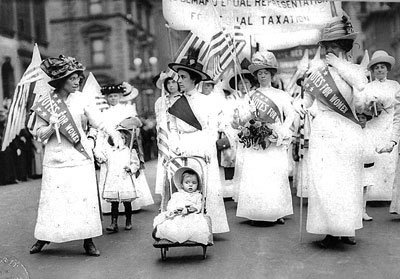
Chiron conjunct Eris seems to be a good one for women’s rights, at least in recent eras. The immediately prior conjunction happened in Pisces between 1917 and 1918, when the American women’s suffrage movement was going strong. Women were given the vote by the 19th Amendment in 1920. Half a century later, Chiron had gone all the way around the solar system and was again conjunct Eris.
Chiron tends to bring out, intensify and focus the properties of any planet that it’s conjunct. Here we have Chiron focusing the disruptive power of Eris, specifically disrupting the known order of reality and, in Aries, of personal identity. In the early 1970s, the feminist movement was again at its peak. There were many developments associated with women’s rights at that time, among them the Roe v. Wadedecision. Whether this chart has Pisces rising or Aries, that rather precise conjunction is in the 1st house; it’s a defining feature of the chart.
If anyone has their doubts that it’s really relevant, the asteroid Magdalena is within one degree of Eris. I think of Magdalena as the woman who is her own person, as well as having attributes of sexwork and sexual healing. The right to choose whether to carry a child to term is all about a woman being her own person.
Mary Magdalene is clearly illustrated at the right hand of Jesus in Leonardo Da Vinci’s painting The Last Supper. She is the very archetype of equal rights for women, and Magdalena’s bold presence in this chart informs our understanding of this asteroid. Its placement in this chart is one of those things that really makes an impression.
Scenario One: Pisces Rising at 10:00 am
In the chart for the stated time of the court going into session that day, the last degree of Pisces is rising. That means the ruler of the ascendant and therefore the significator of the issue is Jupiter, the ruler of Pisces; we find that in Capricorn in the 11th house.
Can you say boring? Well, maybe not boring, but not heaped on with pizazz. Better perhaps: mundane in nature. But then Jupiter is about justice. So we have an image of common sense justice holding up. The Pisces rising chart is a chart about a public policy discussion, involving what is actually a mundane matter of public health. Capricorn is government and policy; the 11th is the public focused on a special issue (all those who might need a safe abortion, and those affected by such a decision) and the court is acting in the public benefit (Jupiter).
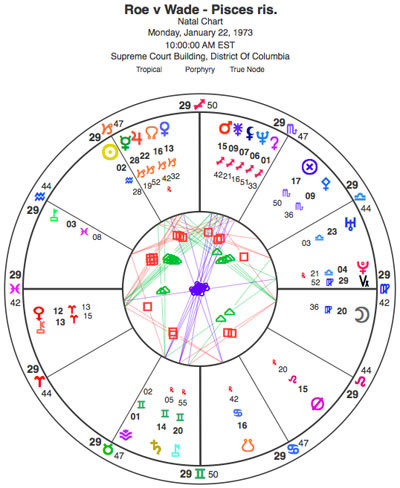
Mercury is close to Jupiter. Mercury rules the 7th house — the opposition. When considered in sane, reasonable and common sense terms (Capricorn), the two sides of the issue are actually pretty close together. Everyone, for example, should be concerned about the health of patients seeking a medical procedure. Even people who oppose abortion would, presumably, not want to see women who seek one bleed to death in an illegal facility.
Capricorn is about restraint. Both sides have a common interest in there being fewer abortions. There are many other points of common ground that both sides could agree on if they wanted to.
Pisces rising has a second potential ruler, which is Venus (I am sticking to traditional rulerships in this discussion). Venus is exalted in Pisces, and has a strong resonance with that sign. We can think of Venus as a second ruler of the issue — and we find her in Capricorn in the 11th house, not far from Jupiter. Here is where we see some of the serious collective and personal pain lurking behind this issue, which is almost always lost in the blaring debate.
Venus in Capricorn makes many aspects to other planets, particularly a square to the Chiron-Eris-Magdalena conjunction in Aries. This is the image of a woman with traditional values coming up against the progress indicated by Chiron-Eris-Magdalena. Venus in Capricorn square these three points is just painful. It may lead to progress, but there is pain, chaos, confusion and an identity crisis to get through first — an accurate depiction of many women at the time this decision came out.
In the 11th house, women’s sexuality is put on display in one of its most sensitive moments: the regret or crisis of a pregnancy that would lead to the need for an abortion. There is often profound shame around unwanted pregnancy, which comes from families, the church and social norms that collectively are described well by Capricorn in the 11th house. You can still hear the stories of children born to mothers who were forced to hide in the house for the duration of their pregnancy, ostensibly to save the family the shame of the pregnant woman being seen in public.
To portray a woman as needing an abortion, in all of the potential shame, moral agony and unnecessary social pressure that comes with it, is about as unglamorous as it gets. It is a woman admitting that there is such a thing as sex for its own sake; that she does not want to be a mother at this particular time; and that she is capable of an error.
I will add that there is a lot of festering residual guilt about all of the abortions that have happened in the past, which is illustrated perfectly by the Venus-Magdalena-Chiron-Eris pattern.
To publicly acknowledge the abortion issue in the Roe v. Wade decision was to put this all on public display. It’s about the whole society admitting the existence and claiming the underside of women’s sexuality. This is a profound source of controversy as we all have some stake in what is done to women.
Scenario Two: Aries Rising at 10:01 am
If we advance the time of the chart by less than a minute, the chart has Aries rising. That makes the planet that rules the question Mars in Sagittarius. This is militant, zealous, driven by opinion and belief and obsessed with religiosity. There is no common sense, logic or thought of the public welfare in the Aries chart. It’s the chart for the over-the-top public reception of the decision, or perhaps how the losers did not take defeat so well.
Emphasizing the point, this is in the 9th house of religion and ideology. And making matters worse, Mars is conjunct the Great Attractor, a massive deep-space point that polarizes issues. Simply put, the 10:01 am chart is a bully pulpit for religious leaders to grandstand their own cause, stir up controversy and make a huge mess on supposedly moral grounds.
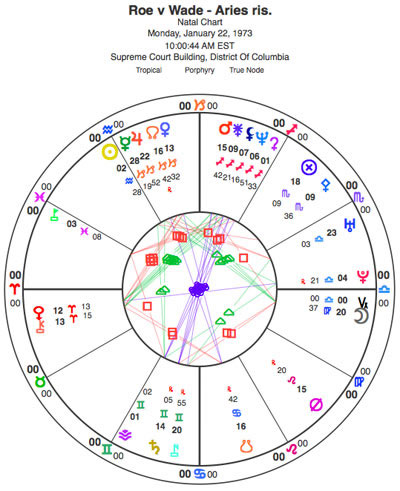
Further, the 9th rules the higher courts, and with the Roe v. Wade decision, the whole issue was pushed — at least for the Pro Life side — into an exclusively judicial forum. The one and only goal surrounding abortion became making abortion illegal.
Now, everyone knows that making something illegal does not stop it. It only pushes it underground, to some extent out of sight and to a large extent outside the ability of government to regulate it. There is also the power trip involved, and it’s basically male in nature (Mars), as well as driven by religious belief which in theory will be dramatized in the courts.
Mars is opposite Saturn, which has the feeling of a hammer coming down on something. Saturn is in Gemini, emphasizing that there are two sides to the issue, but Mars in Sagittarius doesn’t care about that — except for the advantage of causing a polarized controversy. Such is great for raising money for your cause, concentrating political power and getting a years-long adrenaline rush to the thought that you’re doing something bold for the Lord.
The Pro Life camp belies its position by going out of its way to make sure there are more abortions, not fewer of them. The same movements and politicians who will fight to make abortion illegal are opposed to birth control and sex education. The past few years the Pro Life camp has gone on to state its opposition not just to Roe v. Wade but also Griswold v. Connecticut, the decision that makes birth control available to everyone.
Anyone who is really against abortion would want to have fewer unwanted pregnancies. To have fewer unwanted pregnancies, we need to have real sex eduction, widely available birth control, and a society that promotes the values associated with thoughtfulness and with the care of children. The Pro Life position seems to affirm the rights of fetuses only until they are born.
The Aries rising chart describes this as what it is, a religious crusade having no investment in the reality of the human condition. The 9th house where we find Mars is packed with planets and points — there are as many as there are in Capricorn. These include Neptune, which in religious environments can be an inspiration or an intoxicant. There is Ceres, which is about mothers and daughters, and what they go through emotionally. There is the Black Moon Lilith, which can represent the fear of women and their darker tones; and there is Juno, which is about the ‘role of the wife’ as someone who does not get her emotional needs met, and who can barely open her mouth to say what they are.
At the front of the pack is Mars, ready for a religious war at any cost. Fortunately, the United States Supreme Court intervened a moment earlier, reminding everyone that at least for that moment, we were a nation under the rule of law and not religious zealots ready with their nails and crosses.
In the end, however, matters of pregnancy, birth and raising children are about neither law nor religion, and this whole conversation needs to find a new forum if we are to take better care of ourselves and one another.
Lovingly,




